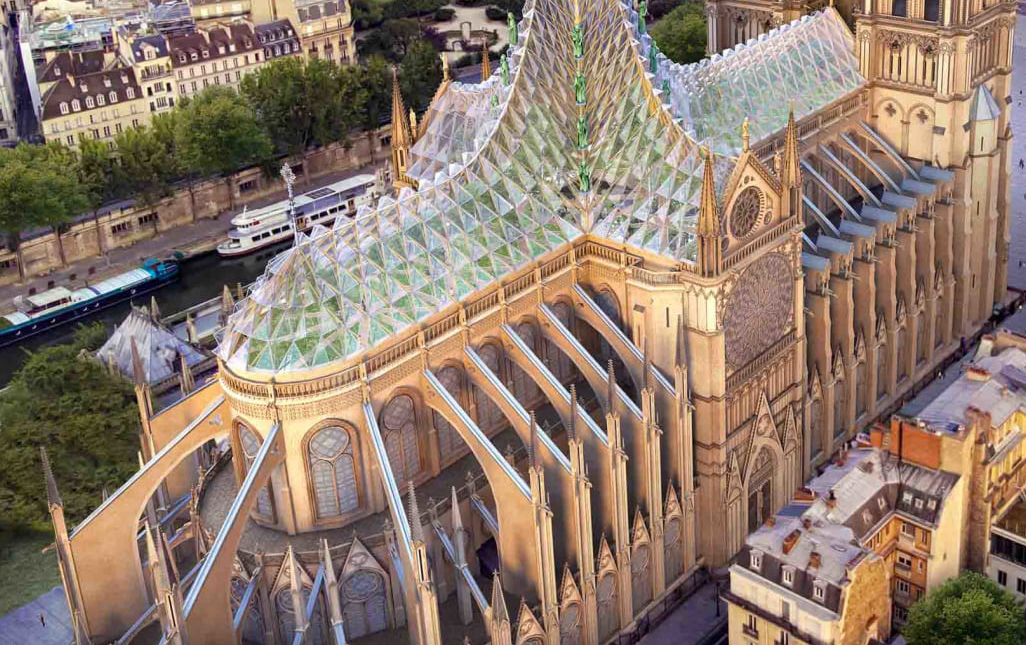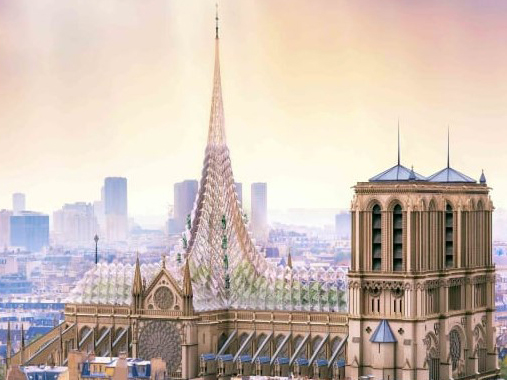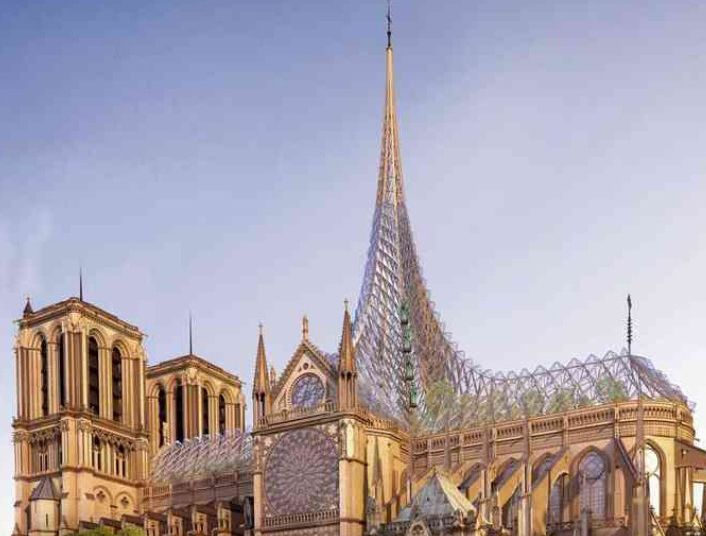Proposed Paris-ND-Cathedral
A BIOSOURCED CONTEMPORARY SPIRE,

A NEW SYMBOL OF SPIRITUAL ASPIRATION
We aim for Palingenesis (Gr. παλιγγενεσία, meaning "rebirth", "regeneration") by harmonizing in one gesture the venerable stone-nave with the roof and spire, through vegetal grafting.
From the four gables, the original geometry of the 10 meter-high attic has been respected. As we move towards the transept cross, its triangular section and steep, 55-degrees pitched roofs gradually stretch to shape a vertical spire.
Thus, respecting the inherent principles of descent of the structural loads of the building towards the flying buttresses and the inner fasciculated pillars, the 4 lines of the roof's ribs bend and join together in harmony towards the sky, producing a parametric and light geometry.
Constructed with cross laminated timber beams pre-stressed with carbon fiber slats , the new oak frame seeks to use the minimum amount of material to ensure a low-carbon footprint while offering the greatest transparency to the cathedral.
Transparency, sharing and openness are the ideas conveyed by this new, diaphanous forest of Notre-Dame, outlining the new face of the Church in the 21st century. A dynamic, agile and contemporary Church.
Its pure and elegant architecture invites us to elevate our spirituality and adopt a much-needed and overly altruistic and humanistic stance towards the world around us, with a view to its better preservation.
The 4 great hip rafters are oriented towards the cardinal points. Between the 4 ridges which give the roof its unique character, their curves reincorporate one above the other the monumental, wrought-copper statues of the 12 apostles, and the tetramorphs, symbolizing the evangelists.
Fortunately, all 16 statues, made by Adolphe Dechaume, were removed 4 days before the fire, on 4/11/19, for restoration.
The rooster will crown the spire again, and will then remain the "spiritual lightning rod" and protector of the faithful.
The new spire, like a shroud raised from the keystone of the transept crossing, evokes the rebirth, but also the mystery of the cathedral and the resurrection of the Celestial Christ. Under the shroud, life and renewal emerge. This way, this Cathedral will dazzle the world again, while amplifying her universal message of peace and her spiritual aspiration.

A Solar and vented roof inspired by BIOMIMICRY
This new architectural "graft" can turn the Notre-Dame into a positive energy building, designed to produce more energy than it needs. Through energetic solidarity with the body of this historic monument, the contemporary, 3D Gothic stained glass graft produces all the electricity, heat and passive ventilation that the cathedral might require, by combining passive systems and advanced renewable energies.
The new wooden frame is covered with a 3D crystal glass dress, subdivided into faceted diamond-shaped elements. Its crystals consist of an organic active layer, made of carbon, hydrogen, nitrogen and oxygen, which absorbs light and transforms it into power. This energy, stored in hydrogen fuel cells, will be directly redistributed throughout the cathedral.
To avoid any greenhouse effect, these crystalline scales open at the bottom of the frame along the acroterion of the nave and transept, creating thereby a natural air flow towards the top of the spire which mimics a wind powered chimney. This natural ventilation, whose operation is akin to the interior of a termite mound, ensures excellent aeraulic performance.
Furthermore, this roof-spire in the cathedral attic provides a thermal buffer space, which accumulates hot air in winter to better isolate the cathedral, and vents with fresh air in the summer through the evapo-transpiration of plants.
The cathedral would be an exemplary eco-engineering structure, and a true pioneer in environmental resiliency.

An urban farm above the Ogive vaults
At its heart, this project features a garden devoted to contemplation and meditation. This garden serves aesthetic but also nourishing purposes. It is cultivated by volunteers to help the most deprived and homeless Parisians.
Aquaponics and permaculture could produce up to 25 kg of fruit and vegetables per m², totaling 21 tons annually. A regular farmers' market could be held on the forecourt of the Notre-Dame to feed these people.
This urban farm is arranged atop the Latin-cross plan of the roof and set in planters, which essentially redraw the layout of 6-part vaults on the ground. This geometric garden "à la française" relies on a double-deck structure with light soil to grow its fruits and vegetables along the nave, from East to West, from the two towers to the apse.
In the North-South axis, the roofs of the transept hosts aquaponic basins feeding plants with natural, fish fertilizers. Moreover, these water mirrors expand the place by reflecting the rose windows on the North and South side gables.


A CHOIR bathed in NATURAL LIGHT
Vincent Callebaut Architectures
A bold proposal to overcome the 2019 collapse of the overweight tower, is to let natural light flood the cathedral from the glazed spire towards the choir.
The large arched vault of the intertransept would be rebuilt in structural glass around its 4 stone ribs, pushing the thrust towards the corners. Natural light would highlight the place's emblematic identity, at the intersection of the main branch of the nave and the transept, offering a new divine atmosphere from the narthex located between the towers.
This is an exemplary project in ecological engineering that feels true to its time and avoids a pastiche architecture that turns the city into an open-air museum.
Circular economy, renewable energies, social innovation, urban agriculture, protection of biodiversity, as well as beauty and spiritual elevation. Our reconstruction proposal feeds on such values to deliver a deep, conscious meaning.
From primitive Gothic in the 12th century, through the radiant Gothic of the 13th century and the flamboyant Gothic of the 14th century, Notre-Dame cathedral undoubtedly arises from centuries of work and multi-faceted inspiration.
PARIS HEARTBEAT

Architects- ZEYU CAI & SIBEI LI
The new spire is interpreted into poly mirrors, gently reflecting the context together with the mirror roof. Every moment, the building will have a new look, matching the changing urban environment. A strong connection among the building, the city and the time has been established by the dramatic reflection. A time capsule, designed to be open every half century, is floating at the top of the spire.
The magnetic levitation installation keeps the memory for the past and reserves the space for future story. New spire represents the memory, presence and hope of the human. Time capsule moves rhythmically up and down, breathing and beating together with the city. The inside reflection of the tower spire creates a city kaleidoscope. The vibrant glass dyes the light while the structure expresses the shadow. The beauty and logic of the Rose Window of Notre-Dame is fully interpreted in the design.
In the center of the kaleidoscope is the floating time capsule. Through reflection, people can see the collage city around with the portrait of themselves at the focal point. The space and time tangled together in this illusory space.
Here, people remind, people confess, people pray. The religious symbol now provides an open answer to the belief and hope for everyone.

